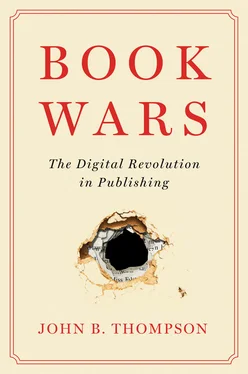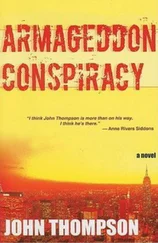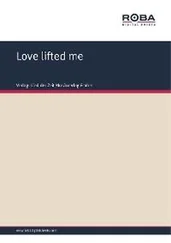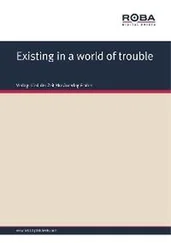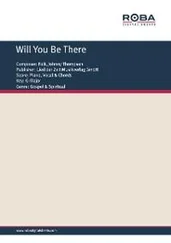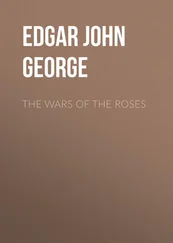At the other end of the scale, juvenile nonfiction has seen very low levels of ebook uptake. The line for this category is flat and hardly rises off the floor of the graph – ebooks accounted for only 2% of Olympic’s revenue in the category of juvenile nonfiction in 2015, rising slightly to 2.6% in 2016. Here we don’t see an S-curve because there has not yet been any perceptible take off in terms of ebook sales in this category of books: 97% of the revenue in 2016 was still being generated by printed books.
Between romance at the top and juvenile nonfiction at the bottom there is a huge range and variation in terms of ebook uptake – each category leaves its own distinctive footprint. But while the trajectories are all unique, the lines band together in certain groups. The top four lines all represent categories of fiction, and the top three lines are all genre fiction categories – romance at the top, followed by mystery and detective fiction, and then sci-fi and fantasy. General fiction is among this set of categories in which ebooks perform strongly, although the line for general fiction is below the genre fiction lines. 7Ebook sales in all four categories show a steep rise between 2008 and 2012, reaching levels that are much higher than with other categories of books. While romance plateaus at around 55% and then fluctuates after that, the other three fiction categories plateau at between 30 and 40%. Most of these categories display some modest decline after the peak period of 2012–14, though ebook sales of romance titles at Olympic experienced a new upsurge in 2016.
The next band of lines in the middle of the graphs all represent nonfiction categories – biography and autobiography, history, business and economics, family and relationships, health and fitness, religion, self-help. Once again, all of these lines rise steeply in the period between 2008 and 2011 and then begin to level off, though at lower levels than the fiction categories. Biography and autobiography and history continued to edge upwards after 2011, reaching 27% in 2015, and then fell sharply after that. Health and fitness reached 24% in 2015 and then began to fall. Other nonfiction categories like business and economics, family and relationships, religion and self-help reached plateaus of between 15 and 20%, and either stabilized at that level or began to fall off. So, between 2011 and 2015, all of these nonfiction categories appear to have plateaued somewhere between 16 and 27% – or, to put it more roughly, between 15 and 25%, with biography and autobiography and history at the top of this band.
At the bottom of the graphs is another set of categories where ebooks have so far failed to take off in any significant way and, by 2016, they still accounted for only a small proportion of overall revenue. Here we find cooking, where ebooks never rose above 5% of sales, juvenile nonfiction, where ebook sales never rose above 3% of sales, and juvenile fiction, where ebooks rose to 12.7% in 2014 and then fell back to 6% in 2016. 8Travel also belongs in this band: ebook sales in travel never took off at Olympic, generally remaining below 12% of total sales, and the spike in 2016 was an anomaly accounted for by particular circumstances at the time. Given that ebooks have not taken off in any significant way in these categories (excluding young adult), the growth lines since 2008 don’t display the pattern of the classic S-curve: they look more like flat lines with gentle inclines that tilt upwards (and occasionally downwards).
Explaining the variations
The data from Olympic make it very clear that there are enormous variations in the uptake of ebooks across different categories of books, and data from other large trade houses would almost certainly display similar patterns – they would not be identical, but the overall patterns would be broadly similar. How can we explain these differences? Why do some categories display much higher percentages of ebook sales relative to total sales, and higher e/p ratios (that is, ebook sales relative to print sales), than other categories?
We can’t explain the differences in terms of the factors that are commonly associated with ebooks – namely, the convenience of being able to purchase ebooks quickly, easily, any time and any place; the convenience of being able to carry multiple ebooks with you wherever you go – indeed, to carry a small library that has no more weight and bulk than a small paperback; the convenience of being able to vary the size of the typeface; and, of course, the price – the fact that ebooks are generally cheaper than print books (though how much cheaper depends on many factors, as we shall see in a later chapter). These factors don’t explain the differences because they are common to all ebooks – a travel book or cookbook is just as easy to purchase and just as lightweight in ebook format as a romance or a thriller. So the explanation must lie elsewhere.
The most striking difference between the categories that sell well as ebooks and those that don’t is that the former consist of narrative linear text and the latter do not. A romance or a thriller is straight narrative text: you generally start reading on p. 1and read continuously until you reach the end (or until you give up). The text is structured as a story with a plot that unfolds sequentially, one step at a time, and the reader follows the sequence. By contrast, a cookbook or a travel book or a practical how-to book is not a book that is generally read from beginning to end. It is more like a reference work that is used for particular purposes – to get a particular recipe, to find information about a city or a country you are planning to visit, to accomplish some practical task. These are very different kinds of books that are read, used and/or consulted in very different ways.
We can understand why this matters in terms of the level of ebook uptake by linking it to the user experience. From the viewpoint of the user, reading narrative linear text on an e-reading device like a Kindle is generally a good experience: you can move easily and swiftly from one page to the next, the text flows smoothly and you, the reader, flow with it from beginning to end. This works particularly well for genre fiction: it’s a fast, immersive read and there is nothing in the device itself, and in the way that the text is presented on the screen, that would obstruct you or slow you down as you follow the plot and move towards the denouement. As those in the business say, the ‘form factor’ is good, where ‘form factor’ refers here to the quality of the experience of reading a particular book on a particular device. The experience of reading genre fiction on an e-reading device like a Kindle is probably as good as – maybe even better than, given the ability to change the type size, etc. – the experience of reading the same text on paper.
However, with non-linear texts that may be more practical in character and/or heavily illustrated, the form factor is nowhere near as good. These non-linear texts are not necessarily meant to be read from beginning to end. They may not tell a story that the reader follows, page by page, in a sequential fashion. A non-linear text like a cookbook or a travel book or a practical how-to book may require the reader or user to jump back and forth, getting the information they need and then perhaps dipping in at another point in the text. They might be used more as a reference work that the reader returns to time and again, possibly to the same place or to another part of the text. For non-linear texts of this kind, the experience of reading or using them on an e-reading device like a Kindle is much less appealing than it is with straight linear texts. And if you then add illustrations, the appeal is likely to diminish still further, especially for readers who have e-reading devices that use black and white e-ink technology, like the Kindle.
Читать дальше
